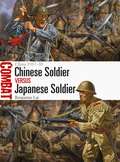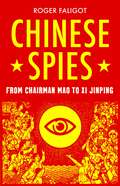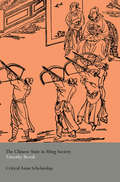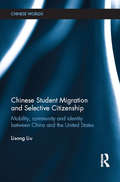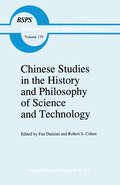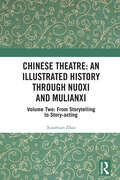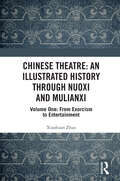- Table View
- List View
Chinese Soldier vs Japanese Soldier: China 1937–38 (Combat)
by Johnny Shumate Benjamin LaiIn July 1937, the Marco Polo Bridge Incident sparked a bloody conflict between Chinese and Japanese forces that would rage across China and beyond for more than eight years. The two sides' forces brought very different strengths and limitations to the conflict. In 1937 China was divided into factions, each controlled by warlords with independent forces, and there was no unified Chinese army. In order to fight the Japanese Chiang Kai-shek, the nominal leader of Nationalist China, was compelled to do deals with these regional powers. For their part, the Japanese employed ground forces broadly comparable to those fielded by Western powers, including modern artillery and tanks. Featuring specially commissioned artwork and drawing upon an array of sources, this study investigates the origins, training, doctrine and armament of the Chinese and Japanese forces who fought in the opening stages of the Second Sino-Japanese War.
Chinese Soldier vs Japanese Soldier: China 1937–38 (Combat)
by Johnny Shumate Benjamin LaiIn July 1937, the Marco Polo Bridge Incident sparked a bloody conflict between Chinese and Japanese forces that would rage across China and beyond for more than eight years. The two sides' forces brought very different strengths and limitations to the conflict. In 1937 China was divided into factions, each controlled by warlords with independent forces, and there was no unified Chinese army. In order to fight the Japanese Chiang Kai-shek, the nominal leader of Nationalist China, was compelled to do deals with these regional powers. For their part, the Japanese employed ground forces broadly comparable to those fielded by Western powers, including modern artillery and tanks. Featuring specially commissioned artwork and drawing upon an array of sources, this study investigates the origins, training, doctrine and armament of the Chinese and Japanese forces who fought in the opening stages of the Second Sino-Japanese War.
The Chinese State in Ming Society (Asia's Transformations/Critical Asian Scholarship)
by Timothy BrookThe Ming dynasty (1368-1644), a period of commercial expansion and cultural innovation, fashioned the relationship between state and society in Chinese history. This unique collection of reworked and heavily illustrated essays, by one of the leading scholars of Chinese history, re-examines this relationship. It argues that, contrary to previous scholarship, it was radical responses within society that led to a 'constitution', not periods of fluctuation within the dynasty itself. Brook's outstanding scholarship demonstrates that it was changes in commercial relations and social networks that were actually responsible for the development of a stable society. This imaginative reconsidering of existing scholarship on the history of China will be fascinating reading for scholars and students interested in China's development.
The Chinese State in Ming Society (Asia's Transformations/Critical Asian Scholarship)
by Timothy BrookThe Ming dynasty (1368-1644), a period of commercial expansion and cultural innovation, fashioned the relationship between state and society in Chinese history. This unique collection of reworked and heavily illustrated essays, by one of the leading scholars of Chinese history, re-examines this relationship. It argues that, contrary to previous scholarship, it was radical responses within society that led to a 'constitution', not periods of fluctuation within the dynasty itself. Brook's outstanding scholarship demonstrates that it was changes in commercial relations and social networks that were actually responsible for the development of a stable society. This imaginative reconsidering of existing scholarship on the history of China will be fascinating reading for scholars and students interested in China's development.
Chinese Statecraft in a Changing World: Demystifying Enduring Traditions and Dynamic Constraints
by Jean DongThis book addresses one of the most pressing geopolitical inquiries of our era: how will China's ambition manifest on the global stage? To address this question, the book considers China’s long tradition of statecraft. By doing this, it provides a unique and novel insight into the “why” behind China’s actions and sparks a crucial dialogue on “how” to best navigate China’s global rise. Through a keen analytical lens, the book illuminates both the constraints and the flexibility inherent in Chinese policy-making. It underscores the geographic and historical factors that constrain China's actions, forcing its leaders into trade-offs. It also highlights the system's inherent flexibility, expanding the range of strategic options available when dealing with China. The most unique contribution consists in framing the pre-occupations of contemporary China in the context of both long-standing Chinese trends and unprecedented global changes. This book offers a nuanced and realistic guide for senior policy makers, business leaders, academic researchers, and global citizens who seek to decipher the enigma of China's ascent and channel its trajectory towards a more positive and responsible direction.
Chinese Strategic Thought toward Asia (Strategic Thought in Northeast Asia)
by G. RozmanThis book traces the development of Chinese thinking over four periods from the 1980s on and covers strategies toward: Russia and Central Asia, Japan, the Korean peninsula, Southeast and South Asia, and regionalism. It compares strategic thinking, arguing that the level was lowest under Jiang Zemin and highest under Hu Jintao.
Chinese Student Migration and Selective Citizenship: Mobility, Community and Identity Between China and the United States (Chinese Worlds)
by Lisong LiuSince China began its open-door and reform policies in 1978, more than three million Chinese students have migrated to study abroad, and the United States has been their top destination. The recent surge of students following this pattern, along with the rising tide of Chinese middle- and upper-classes' emigration out of China, have aroused wide public and scholarly attention in both China and the US. This book examines the four waves of Chinese student migration to the US since the late 1970s, showing how they were shaped by the profound changes in both nations and by US-China relations. It discusses how student migrants with high socioeconomic status transformed Chinese American communities and challenged American immigration laws and race relations. The book suggests that the rise of China has not negated the deeply rooted "American dream" that has been constantly reinvented in contemporary China. It also addresses the theme of "selective citizenship" – a way in which migrants seek to claim their autonomy - proposing that this notion captures the selective nature on both ends of the negotiations between nation-states and migrants. It cautions against a universal or idealized "dual citizenship" model, which has often been celebrated as a reflection of eroding national boundaries under globalization. This book draws on a wide variety of sources in Chinese and English, as well as extensive fieldwork in both China and the US, and its historical perspective sheds new light on contemporary Chinese student migration and post-1965 Chinese American community. Bridging the gap between Asian and Asian American studies, the book also integrates the studies of migration, education, and international relations. Therefore, it will be of interest to students of these fields, as well as Chinese history and Asian American history more generally.
Chinese Student Migration and Selective Citizenship: Mobility, Community and Identity Between China and the United States (Chinese Worlds)
by Lisong LiuSince China began its open-door and reform policies in 1978, more than three million Chinese students have migrated to study abroad, and the United States has been their top destination. The recent surge of students following this pattern, along with the rising tide of Chinese middle- and upper-classes' emigration out of China, have aroused wide public and scholarly attention in both China and the US. This book examines the four waves of Chinese student migration to the US since the late 1970s, showing how they were shaped by the profound changes in both nations and by US-China relations. It discusses how student migrants with high socioeconomic status transformed Chinese American communities and challenged American immigration laws and race relations. The book suggests that the rise of China has not negated the deeply rooted "American dream" that has been constantly reinvented in contemporary China. It also addresses the theme of "selective citizenship" – a way in which migrants seek to claim their autonomy - proposing that this notion captures the selective nature on both ends of the negotiations between nation-states and migrants. It cautions against a universal or idealized "dual citizenship" model, which has often been celebrated as a reflection of eroding national boundaries under globalization. This book draws on a wide variety of sources in Chinese and English, as well as extensive fieldwork in both China and the US, and its historical perspective sheds new light on contemporary Chinese student migration and post-1965 Chinese American community. Bridging the gap between Asian and Asian American studies, the book also integrates the studies of migration, education, and international relations. Therefore, it will be of interest to students of these fields, as well as Chinese history and Asian American history more generally.
Chinese Studies in the History and Philosophy of Science and Technology (Boston Studies in the Philosophy and History of Science #179)
by Robert S. Cohen FanDainianThe articles in this collection were all selected from the first five volumes of the Journal of Dialectics of Nature published by the Chinese Academy of Sciences between 1979 and 1985. The Journal was established in 1979 as a comprehensive theoretical publication concerning the history, philosophy and sociology of the natural sciences. It began publication as a response to China's reform, particularly the policy of opening to the outside world. Chinese scholars began to undertake distinctive, original research in these fields. This collection provides a cross-section of their efforts during the initial phase. To enable western scholars to understand the historical process of this change in Chinese academics, Yu Guangyuan's `On the Emancipation of the Mind' and Xu Liangying's `Essay on the Role of Science and Democracy in Society' have been included in this collection. Three of the papers included on the philosophy of science are discussions of philosophical issues in cosmology and biology by scientists themselves. The remaining four are written by philosophers of science and discuss information and cognition, homeostasis and Chinese traditional medicine, the I Ching (Yi Jing) and mathematics, etc. Papers have been selected on the history of both classical and modern science and technology, the most distinctive of which are macro-comparisons of the development of science in China and the west. Some papers discuss the issue of the demarcation of periods in the history of science, the history of ancient Chinese mathematics, astronomy, metallurgy, machinery, medicine, etc. Others discuss the history of modern physics and biology, the history of historiography of science in China and the history of regional development of Chinese science and technology. Also included are biographies of three post-eighteenth-century Chinese scholars, Li Shanlan (1811-1882), Hua Hengfang (1833&endash;1902), and Cai Yuanpei (1868&endash;1940), who contributed greatly to the introduction of western science and scholarship to China. In addition, three short papers have been included introducing the interactions between Chinese scholars and three great western scientists, Niels Bohr, Norbert Wiener, and Robert A. Millikan.
Chinese Sympathies: Media, Missionaries, and World Literature from Marco Polo to Goethe (Signale: Modern German Letters, Cultures, and Thought)
by Daniel Leonhard PurdyChinese Sympathies examines how Europeans—German-speaking writers and thinkers in particular—identified with Chinese intellectual and literary traditions following the circulation of Marco Polo's Travels. This sense of affinity expanded and deepened, Daniel Leonhard Purdy shows, as generations of Jesuit missionaries, baroque encyclopedists, Enlightenment moralists, and translators established intellectual regimes that framed China as being fundamentally similar to Europe. Analyzing key German literary texts—theological treatises, imperial histories, tragic dramas, moral philosophies, literary translations, and poetic cycles—Chinese Sympathies traces the paths from baroque-era missionary reports that accommodated Christianity with Confucianism to Goethe's concept of world literature, bridged by Enlightenment debates over cosmopolitanism and sympathy, culminating in a secular principle that allowed readers to identify meaningful similarities across culturally diverse literatures based on shared human experiences.Thanks to generous funding from Penn State University, the ebook editions of this book are available as Open Access volumes from Cornell Open (cornellopen.org) and other repositories.
Chinese Theatre: Volume Two: From Storytelling to Story-acting
by Xiaohuan ZhaoChinese Theatre: An Illustrated History Through Nuoxi and Mulianxi is the first book in any language entirely devoted to a historical inquiry into Chinese theatre through Nuoxi and Mulianxi, the two most representative and predominant forms of Chinese temple theatre. Volume Two is a continuation of the historical inquiry into Chinese theatre with focus shifted from Mulian storytelling to Mulian story-acting. Thus, this volume traces the historical trajectory of xiqu from Northern dramas to Southern dramas and from elite court theatre to mass regional theatre with pivotal forms and functions of Mulianxi examined, explicated and illustrated in association with the development of corresponding genres of xiqu. In so doing, every aspect of Mulianxi is considered not in the margins of xiqu but in and of itself. While this volume is primarily concerned with Mulianxi, references are also made to other forms of Chinese performing arts and temple theatre, Nuoxi in particular, as Mulianxi has been performed since the twelfth century as, or in company with, Nuoxi, to cleanse the community of evil spirits and epidemic diseases. This is an interdisciplinary book project that is aimed to help researchers and students of theatre history understand the ritual origins of Chinese theatre and the dynamic relationships among myth, ritual, religion and theatre.
Chinese Theatre: Volume Two: From Storytelling to Story-acting
by Xiaohuan ZhaoChinese Theatre: An Illustrated History Through Nuoxi and Mulianxi is the first book in any language entirely devoted to a historical inquiry into Chinese theatre through Nuoxi and Mulianxi, the two most representative and predominant forms of Chinese temple theatre. Volume Two is a continuation of the historical inquiry into Chinese theatre with focus shifted from Mulian storytelling to Mulian story-acting. Thus, this volume traces the historical trajectory of xiqu from Northern dramas to Southern dramas and from elite court theatre to mass regional theatre with pivotal forms and functions of Mulianxi examined, explicated and illustrated in association with the development of corresponding genres of xiqu. In so doing, every aspect of Mulianxi is considered not in the margins of xiqu but in and of itself. While this volume is primarily concerned with Mulianxi, references are also made to other forms of Chinese performing arts and temple theatre, Nuoxi in particular, as Mulianxi has been performed since the twelfth century as, or in company with, Nuoxi, to cleanse the community of evil spirits and epidemic diseases. This is an interdisciplinary book project that is aimed to help researchers and students of theatre history understand the ritual origins of Chinese theatre and the dynamic relationships among myth, ritual, religion and theatre.
Chinese Theatre: Volume One: From Exorcism to Entertainment
by Xioahuan ZhaoChinese Theatre: An Illustrated History Through Nuoxi and Mulianxi is the first book in any language entirely devoted to a historical inquiry into Chinese theatre through Nuoxi and Mulianxi, the two most representative and predominant forms of Chinese temple theatre. With a view to evaluating the role of temple theatre in the development of xiqu or traditional Chinese theatre and drama from myth to ritual to ritual drama to drama, Volume One provides a panoramic perspective that allows every aspect of Nuoxi to be considered, not in the margins of xiqu but in and of itself. Thus, this volume traces xiqu history from its shamanic roots in exorcism rituals of Nuo to various forms of ritual and theatrical performance presented at temple fairs, during community and calendrical festivals or for ceremonial functions over the course of imperial history, and into the twenty-first century, followed by an exploration of the scriptural origins and oral traditions of Mulianxi, with pivotal forms and functions of Nuoxi and Mulian storytelling, examined, explicated and illustrated in association with the development of corresponding genres of Chines performance literature and performing arts. This is an interdisciplinary book project that is aimed to help researchers and students of theatre history understand the ritual origins of Chinese theatre and the dynamic relationships among myth, ritual, religion, and theatre.
